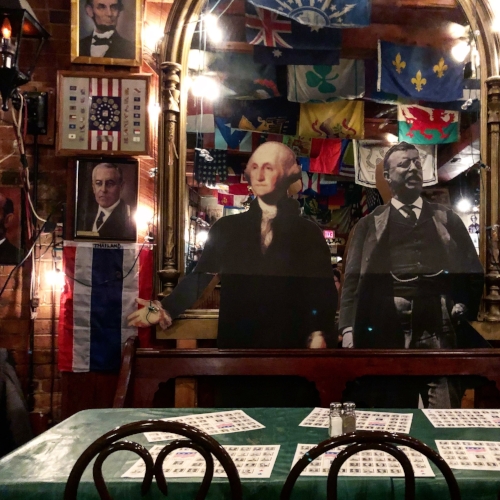In 2018, I had the ability to attend eight (!!) conferences. With the unique opportunity to attend four national preservation conferences in one year, I wanted to delve into mini reviews on each conference with recommendations.* Want to know what speakers left the most food for thought? Read my blog, Top Five Conference Sessions Of 2018!
Main Street Now
Main Street Now offers a virtual competition for conference attendees. These lovely ladies posed with Tiny Jane Jacobs to get points for the game!
Location: Kansas City, Missouri
Was There: Main Street Managers, Government Employees, Preservation Consultants, Planning Consultants
Exhibition Area: The exhibition area featured a large variety of vendors ranging from custom ornaments of historic homes to planters to consultants and more! This was the largest exhibitor hall of the conferences I attended this year and visitation was encouraged with a happy hour.
Next Conference: March 25-27, 2019; Seattle, Washington
Recommended if you are… working to revitalize a neighborhood, Main Street, or urban area! Whether you are looking to learn placemaking initiatives, ways to transform vacant storefronts into activated spaces, or engage community members this is a great conference for you.
Forum: National Alliance for Preservation Commissions
Forum attendees had the opportunity to take a bike tour of downtown Des Moines to learn about the city’s architecture and urban planning history.
Location: Des Moines, Iowa
Who Was There: Government Employees, Architectural Review Board Members, Preservation Consultants
Exhibition Area: There was a very small exhibition area compared to the other national conferences.
Next Conference: July 22-26, 2020; Tacoma, Washington
Recommended if you are… working in any capacity with or for the government! Consultants who work on design guidelines, city planning, and other aspects of local government would also benefit from attending.
Association for Preservation Technology
The conference after parties are an important part of the event! Network with your peers and build meaningful relationships. Attendees enjoyed Buffalo’s Founding Fathers dive bar during the Association for Preservation Technology conference.
Location: Buffalo, New York
Who Was There: Architects, Conservators, Preservation Consultants, Students
Exhibition Area: Very nice exhibition area for building materials and architectural conservation firms. There was a wonderful selection of physical examples of contemporary materials to replace historic building fabric.
Next Conference: November 19-23, 2019; Miami, Florida
Recommended if you are…working to restore buildings! Whether you are physically doing the restoration work, writing historic tax credit applications, or an architect reimagining older buildings, you will find something to enhance your toolkit. This conference will have you thinking through conservation vs restoration and best strategies to physically maintain heritage.
PastForward: National Trust for Historic Preservation**
Make sure to schedule time for yourself during a conference. You never know what you may find within a few blocks of the conference venue! In San Francisco, PastForward attendees could easily walk to this Frank Lloyd Wright designed commercial space.
Location: San Francisco, California
Who Was There: Preservation Consultants, Architects, Nonprofit Employees, Students
Exhibition Area: The exhibition area was smaller than previous PastForward conferences, but vendors had a very good location for engaging attendees. Vendors were located directly outside the main ballroom where attendees flowed in and out at least once a day for for a presentation in the ballroom.
Next Conference: October 10-12, 2019; Denver, Colorado
Recommended if you are…interested in expanding your preservation perspective! PastForward presents a large volume of thought provoking sessions and delves into a myriad of practical sessions as well. This conference should appeal to a variety of preservation professionals. The National Trust for Historic Preservation has their “TrustLive” sessions online for you to view if you are curious to know more.
Statewide Historic Preservation Conferences
Every statewide historic preservation conference has a different emphasis based on the focus of the hosting organization. While I am not going to individually review the statewide conferences I attended this year, I will encourage you to consider attending other statewide conferences in your region. You do not have to attend all of them annually, but consider mixing things up periodically and learning from your nearby peers.
My conference travel bud for three conferences this year was Lindsay Jones of Blind Eye Restoration. Check out her conference perspective over here.
Which Conference(s) will I Choose to Attend in the Future?
When looking toward the future of my continuing education, I consider a number of factors.
1- Cost (Check out my blog Buying Down Conference Costs)
2- Time, does the conference align with my schedule
3-Educational value for me at this stage in my career. This is the most important factor when determining the benefits of a conference. I attend conferences for the educational value, the opportunity to network, and the ability to learn more about the work of my peers.
2019
In 2019, I am currently scheduled to attend the Colorado Saving Places Conference, the Preservation New York State Conference, and Toolkits and Wheelhouses: Michigan Historic Preservation Network Annual Conference. I am also planning to attend the annual Heritage Ohio Conference dependent on the dates. Statewide conferences are incredibly valuable to attend, because each state operates with different rules, regulations, financial incentives etc. Attending statewide conferences easily allow you to learn new strategies and toolkits that you can bring back home.
The only national preservation conference I am currently considering attending in 2019 is PastForward, the National Trust for Historic Preservation’s annual conference. At this time I find this conference to be the best at discussing diversity and inclusion issues in the field and hosting presentations that delve into the preservation of lesser known histories. These presentations always leave me with food for thought and new ideas.
While Modern Phoenix Week is not technically a conference, I am also looking forward to attending this annual event. The structure of the week allows you to select individual lectures, tours, workshops, or other events based on your interest. Advocating for the preservation of mid century modern assets is growing in importance in the historic preservation field and attending this week will strengthen my modernism advocacy toolkit.
2020 and Beyond
I plan to develop a strategy on how frequently I should attend the National Alliance for Preservation Commissions, Association for Preservation Technology, and Main Street conferences. By periodically attending each of these conferences I will ensure my knowledge of their focusses: local design review, restoration/conservation and materials, and community revitalization, stays current and ensures I can be the strong historic preservation advocate and educator.
In addition to these conferences that I have previously attended, I keep a list of conferences I would like to attend in the future. This list includes: American Association of State and Local History, Roadside Architecture, and other statewide conferences. I’m also interested in attending international historic preservation conferences to gain a greater understanding of the field overseas or to our north at the National Trust for Canada Conference.
What About You?
Consider your continuing education goals and determine whether a conference, workshop, webinar, or courses at a college are right for you. There are benefits to each learning strategy depending on your time, budget, and ability to travel. I’d also strongly encourage you to try new conferences that you have not previously attended or have not attended for a number of years. You may be surprised what they are offering.
Do not hesitate to reach out via me@sarahmarsom.com if you have any questions regarding my conference experiences this year.
*By participating as a speaker or in another capacity at these conferences I was able to substantially reduce my conference registration fees to allow attendance.
**PastForward is the only national historic preservation conference I have attended prior to this year














